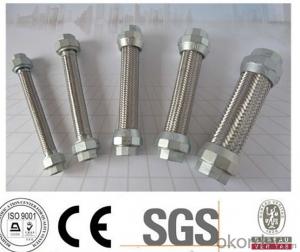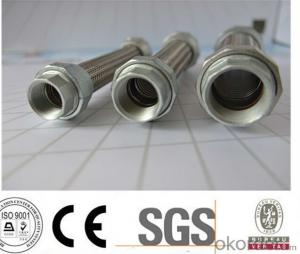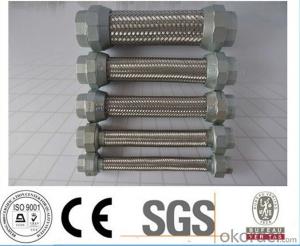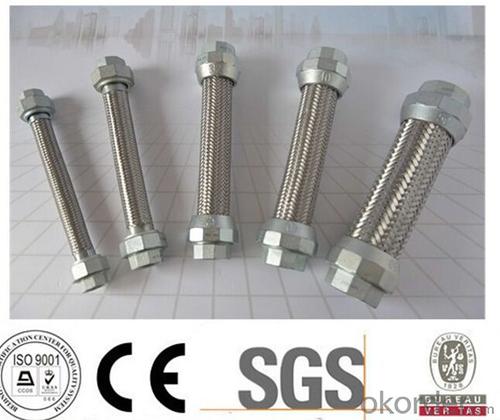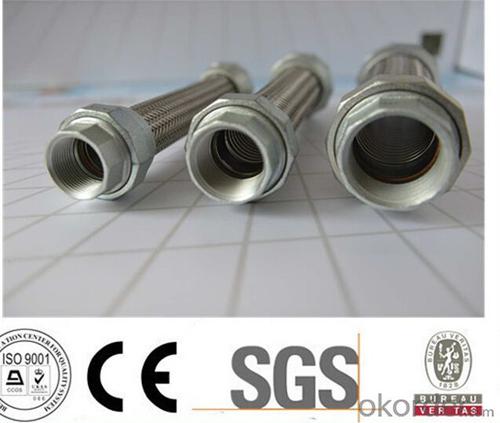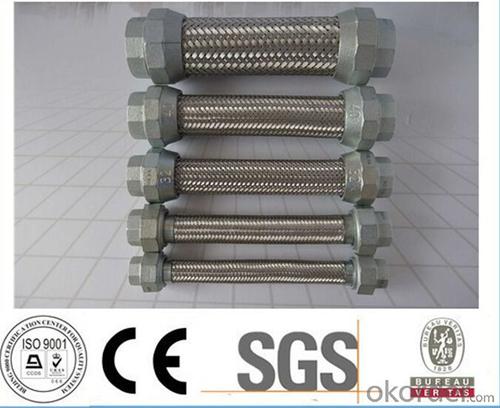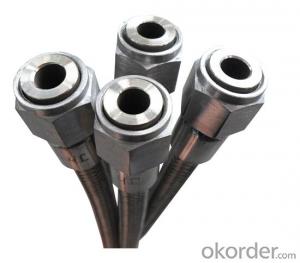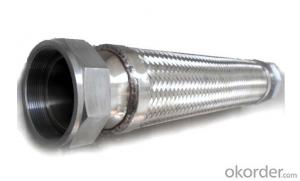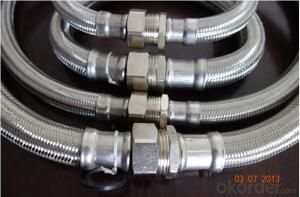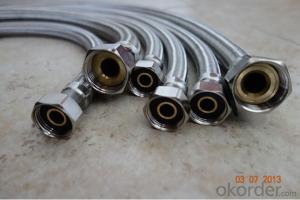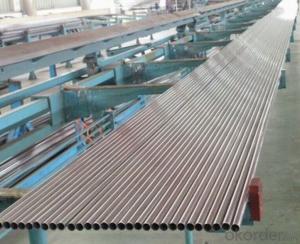Stainless Steel Braid Hose with Special Treatment
- Loading Port:
- Tianjin
- Payment Terms:
- TT OR LC
- Min Order Qty:
- 1000 pc
- Supply Capability:
- 100000 pc/month
OKorder Service Pledge
OKorder Financial Service
You Might Also Like
Specification
Stainless Steel Braid Hose with Special Treatment
Applications of Stainless Steel Braid Hose with Special Treatment:
--Refueling system
--Chemical and pharmaceutical industry
--Industrial hydraulic systems
--Air conditioners in industrial and construction –site vehicles
--Food and beverage industry
--Special and standard industrial applications
--Water and cleaning management
Features of Stainless Steel Braid Hose with Special Treatment:
1. )O. D.: 13-18MM 0.2-3M long
2. )Nut.: Nickel/Chrome Plated Brass (Zinc / Iron / Aluminum is available)
3. )Size Of Nut.: Female&Male 1/2''; 3/4''; 3/8''; 7/8''; 5/16'', and M10...
4. )Insert.: Brass (Zinc / Aluminum / Plastic is available)
5. )Inner tube.: Rubber/ EPDM/PVC
6. )Covered Material: Stainless Steel 201, 301, 304 /Aluminium Wire
7. )Working Pressure: 5Kg-15Kg
8. )Temperature: 0-92° C
9. )Quality Assurance: 3 years
RemarkAPPLICATION: HOUSEEHOLD WARE, BATHROOM WARE, SHOWER HOSE
PAYMENT: T/T, L/C
DELIVERY TIME: 20DAYS OR 30DAYS AFTER RECEIVED 30% DEPOSITS
MOQ: 5000PCS
ODM&OEM IS ACCEPTABLE
PackageInner: PP bag /Blister packing Outer: Carton box
Specifications of Stainless Steel Braid Hose with Special Treatment:
NO | I.D | Refer to O.D | Working pressure | Burst pressure | approximate Weight | |||||
(inch) | (mm) | (inch) | (mm) | MPa | Psi | MPa | Psi | kg/m | lbs/ft | |
1 | 1/8 | 3.2±0.2 | 0.35 | 9±0.3 | 2.06 | 300 | 8.27 | 1200 | 0.078 | 0.12 |
2 | 5/32 | 4±0.2 | 0.4 | 10±0.3 | 2.06 | 300 | 8.27 | 1200 | 0.092 | 0.14 |
3 | 3/16 | 4.8±0.2 | 0.43 | 11±0.3 | 2.06 | 300 | 8.27 | 1200 | 0.108 | 0.16 |
4 | 1/4 | 6.3±0.3 | 0.5 | 12.7±0.3 | 2.06 | 300 | 8.27 | 1200 | 0.134 | 0.2 |
5 | 5/16 | 8.0±0.3 | 0.56 | 14±0.3 | 2.06 | 300 | 8.27 | 1200 | 0.147 | 0.22 |
6 | 3/8 | 9.5±0.3 | 0.63 | 16±0.4 | 2.06 | 300 | 8.27 | 1200 | 0.182 | 0.27 |
7 | 15/32 | 12±0.3 | 0.75 | 19±0.5 | 2.06 | 300 | 8.27 | 1200 | 0.238 | 0.35 |
8 | 1/2 | 12.7±0.4 | 0.78 | 20±0.5 | 2.06 | 300 | 8.27 | 1200 | 0.262 | 0.39 |
9 | 5/8 | 16±0.4 | 0.94 | 24±0.5 | 1.03 | 150 | 4.12 | 600 | 0.351 | 0.52 |
10 | 3/4 | 19±0.4 | 1.13 | 28.8±0.5 | 1.03 | 150 | 4.12 | 600 | 0.515 | 0.77 |
11 | 1 | 25.4±0.5 | 1.38 | 35±0.6 | 1.03 | 150 | 4.12 | 600 | 0.637 | 0.95 |
Images of Stainless Steel Braid Hose with Special Treatment:
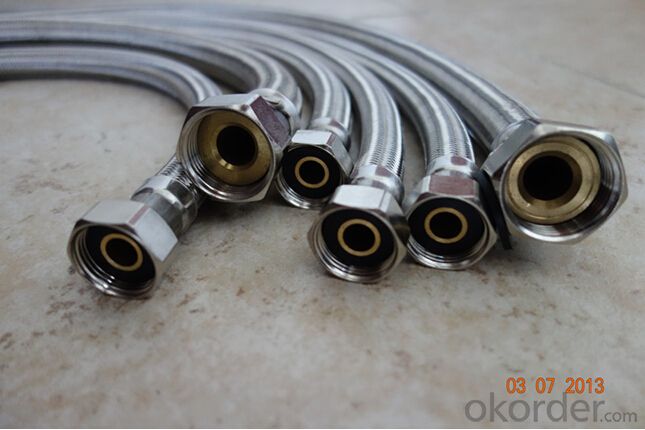
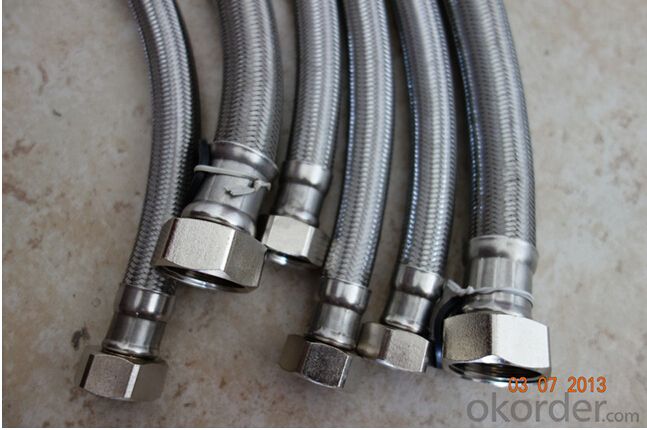
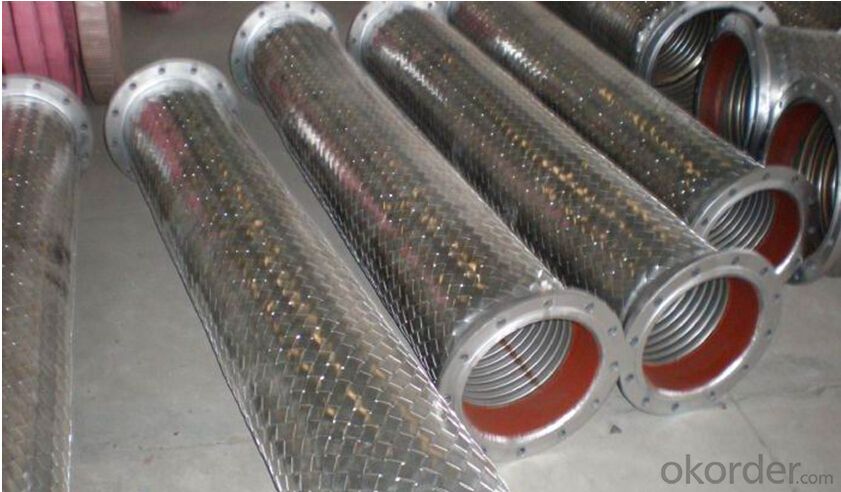
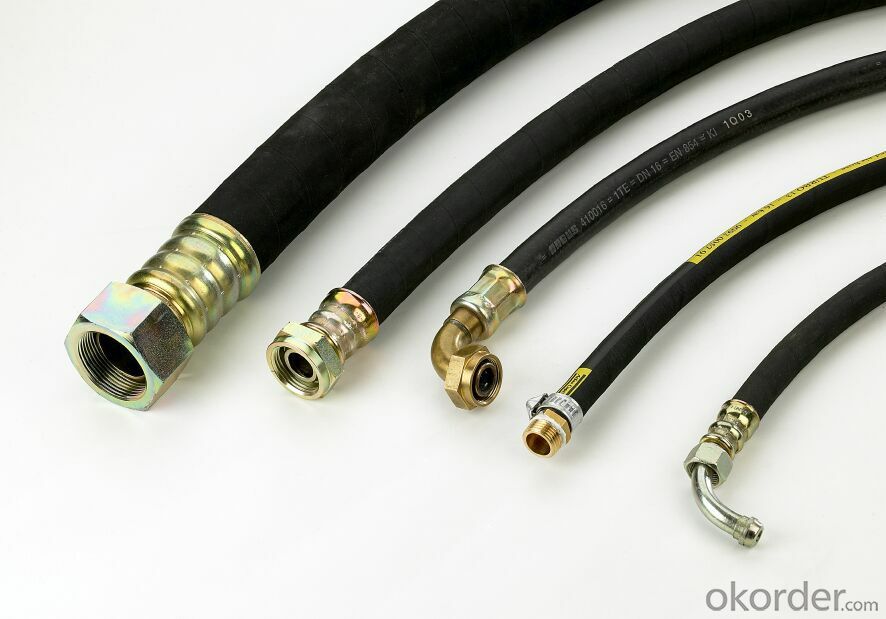
Package of Stainless Steel Braid Hose with Special Treatment:
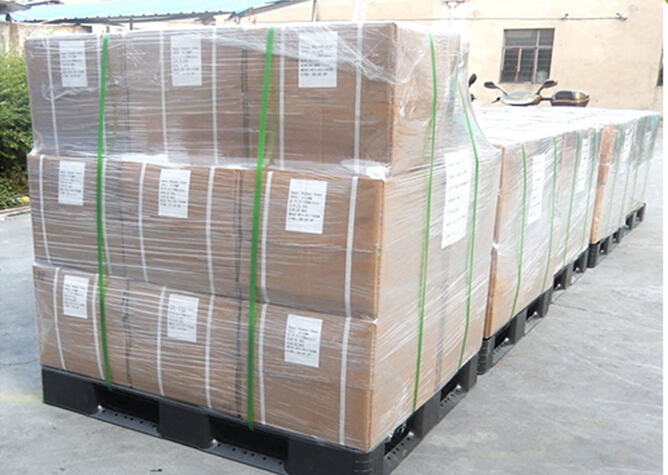

FAQ of Stainless Steel Braid Hose with Special Treatment:
Who we are:
Answer: We CNBM is a Chinese state-owned enterprise ranked 267th among the Global Fortune 500, as the largest building materials company,we have over 300 affiliated companies,and so many production lines and branch office distribute in China.
2. About our quality:
Answer: Every product needs to be quality proved before shipping.
3. About our service:
Answer: We could gurantte that we can reply you in 2 working hours.
- Q: How do you calculate the expansion of stainless steel pipes?
- In order to calculate the expansion of stainless steel pipes, it is necessary to take into account the coefficient of thermal expansion (CTE) of the material. The CTE quantifies the extent to which a material expands or contracts when exposed to temperature changes. To begin, the initial length of the stainless steel pipe must be determined. This refers to the length of the pipe at the starting temperature. Subsequently, the final operating temperature of the pipe needs to be established. This denotes the temperature at which the expansion is desired to be calculated. The CTE value for the specific grade of stainless steel used in the pipe must be obtained. The CTE is typically expressed in units of per degree Celsius (or per degree Fahrenheit). Multiply the initial length of the pipe by the CTE value and then multiply it by the change in temperature. This computation yields the expansion or contraction of the pipe within the given temperature range. For instance, assume a stainless steel pipe with an initial length of 10 meters, a CTE of 17 x 10^-6 per degree Celsius, and a desired expansion calculation at a final temperature of 100 degrees Celsius. The change in temperature is determined by subtracting the initial temperature from the final temperature. Expansion = Initial Length * CTE * Change in Temperature Expansion = 10 meters * 17 x 10^-6 per degree Celsius * 100 degrees Celsius Expansion = 0.0017 meters or 1.7 millimeters Consequently, when subjected to a temperature increase of 100 degrees Celsius, the stainless steel pipe would expand by 1.7 millimeters. It is important to note that this calculation assumes a uniform expansion throughout the entire length of the pipe. In reality, thermal expansion may vary due to factors such as pipe diameter, wall thickness, and other structural considerations. Thus, it is advisable to consult industry standards or engineering references for more precise calculations in specific applications.
- Q: Can stainless steel pipes be used for mining applications?
- Yes, stainless steel pipes can be used for mining applications. Stainless steel is known for its excellent corrosion resistance and durability, making it suitable for the harsh environments and demanding conditions typically found in mining operations. Additionally, stainless steel pipes are capable of withstanding high temperatures, pressures, and abrasion, making them a reliable choice for various mining applications such as transporting fluids, slurry, and chemicals.
- Q: How do you prevent backflow in stainless steel pipes?
- To prevent backflow in stainless steel pipes, there are a few key measures that can be taken. 1. Install a backflow preventer: This is a mechanical device that is installed in the pipe system to ensure that water flows in one direction and prevents any backflow. There are different types of backflow preventers available, such as check valves, double check valves, and reduced pressure zone devices. The selection of the appropriate backflow preventer depends on the specific requirements of the system and local codes and regulations. 2. Regular maintenance and inspection: It is important to regularly inspect the backflow preventer and ensure it is functioning properly. Any signs of wear or damage should be addressed immediately to prevent potential backflow issues. Regular maintenance can also include cleaning and replacing any worn-out parts to ensure optimal performance. 3. Pressure regulation: Maintaining proper pressure in the stainless steel pipes can also help prevent backflow. High pressure can cause water to flow in the opposite direction, leading to backflow. By installing pressure regulators or pressure-reducing valves, the water pressure can be controlled and maintained within the recommended range. 4. Air gaps: Incorporating air gaps in the system can provide an additional layer of protection against backflow. An air gap is a physical separation between the water source and the point of use, ensuring that there is no direct connection that could allow backflow to occur. 5. Adequate system design: Proper system design is crucial in preventing backflow. By ensuring that the stainless steel pipes have the correct sizing, appropriate slope, and proper connections, the risk of backflow can be minimized. Additionally, locating the backflow preventer in an easily accessible area can facilitate regular maintenance and inspection. By implementing these preventive measures, the risk of backflow in stainless steel pipes can be significantly reduced, promoting the safe and efficient flow of water in the system.
- Q: Can stainless steel pipes be insulated with polyethylene?
- Yes, stainless steel pipes can be insulated with polyethylene. Polyethylene is a commonly used insulation material for pipes due to its excellent thermal properties and high resistance to moisture. It provides effective insulation to prevent heat loss or gain from the pipe, which is important for applications that require temperature control. Additionally, polyethylene is lightweight, flexible, and easy to install, making it a suitable choice for insulating stainless steel pipes. However, it is essential to ensure that the polyethylene insulation is compatible with the specific type of stainless steel being used to avoid any potential chemical reactions or corrosion.
- Q: Can stainless steel pipes be insulated with PVC?
- No, stainless steel pipes cannot be insulated with PVC.
- Q: What is the difference between 2205 and 316L stainless steel pipes?
- The main difference between 2205 and 316L stainless steel pipes lies in their composition and properties. 2205 stainless steel is a duplex stainless steel, meaning it consists of a combination of austenite and ferrite phases. This composition provides excellent corrosion resistance and high strength. It is commonly used in applications that require resistance to stress corrosion cracking, such as marine environments and chemical processing plants. On the other hand, 316L stainless steel is an austenitic stainless steel known for its high corrosion resistance. It contains a higher percentage of chromium and nickel, which gives it superior resistance to pitting and crevice corrosion. It is commonly used in industries such as food processing, pharmaceuticals, and medical devices. In summary, while both 2205 and 316L stainless steel pipes offer corrosion resistance, 2205 provides higher strength and resistance to stress corrosion cracking, while 316L offers better resistance to pitting and crevice corrosion. The choice between the two will depend on the specific requirements of the application.
- Q: How do stainless steel pipes compare to carbon fiber pipes?
- Stainless steel pipes and carbon fiber pipes have their own unique characteristics and are used in different applications. Stainless steel pipes are known for their durability and strength. They are highly resistant to corrosion and can withstand high temperatures and pressures. This makes them suitable for various industries such as oil and gas, chemical, and construction. Stainless steel pipes have a longer lifespan and can handle heavy loads, making them a reliable choice for many applications. However, stainless steel pipes are relatively heavy and may require additional support structures. On the other hand, carbon fiber pipes are lightweight and have a high strength-to-weight ratio. They are made from carbon fibers embedded in a resin matrix, resulting in a strong and rigid material. Carbon fiber pipes are commonly used in industries such as aerospace, automotive, and sports equipment. The lightweight nature of carbon fiber pipes allows for increased fuel efficiency in vehicles and improved performance in sports equipment. However, carbon fiber pipes are more expensive than stainless steel pipes and may not be as resistant to extreme temperatures or corrosive environments. In summary, stainless steel pipes are known for their durability and resistance to corrosion, making them suitable for heavy-duty applications. Carbon fiber pipes, on the other hand, are lightweight and offer high strength-to-weight ratio, making them ideal for applications where weight reduction is critical. The choice between stainless steel and carbon fiber pipes ultimately depends on the specific requirements of the application and the trade-offs between cost, weight, and performance.
- Q: What is the chemical composition of stainless steel pipes?
- Stainless steel pipes are primarily composed of iron, chromium, and varying amounts of other elements depending on the specific grade or type of stainless steel. The main component is iron, which provides the structural strength and durability. Chromium is the key element that gives stainless steel its corrosion-resistant properties. It forms a thin, passive layer on the surface of the steel, protecting it from oxidation and rust. Other elements commonly found in stainless steel pipes include nickel, molybdenum, and manganese, which further enhance its corrosion resistance, strength, and other specific properties. The specific chemical composition of stainless steel pipes can vary widely depending on the grade and intended application, allowing for different levels of strength, corrosion resistance, and heat resistance.
- Q: Can stainless steel pipes be used for sewage disposal?
- Yes, stainless steel pipes can be used for sewage disposal. Stainless steel is a highly durable and corrosion-resistant material, making it suitable for handling sewage and wastewater. It is resistant to various chemicals and acids commonly found in sewage, ensuring the pipes' longevity and minimizing the risk of leaks or breaks. Additionally, stainless steel pipes have smooth inner surfaces, which helps prevent the buildup of waste and inhibits the growth of bacteria or other harmful substances. Overall, stainless steel pipes are a reliable and appropriate choice for sewage disposal systems.
- Q: What are the connecting methods of stainless steel pipes for indoor water pipes?
- Card type features: easy to install, connecting the external pipe, the internal rubber ring is evenly compressed into hexagonal. Scope of application: cold water system, pipe direct drinking water system, and more suitable for pipe installation. The utility model has the advantages that the connection is simple and convenient, the working hours are short, and the cost is moderate. Drawback is the single application, the maintenance of trouble, both the pipe sealing ring in aging and need to be replaced more trouble, because the connection was stuck, replacement is the need to both ends of the pipe to replace the sawing.
Send your message to us
Stainless Steel Braid Hose with Special Treatment
- Loading Port:
- Tianjin
- Payment Terms:
- TT OR LC
- Min Order Qty:
- 1000 pc
- Supply Capability:
- 100000 pc/month
OKorder Service Pledge
OKorder Financial Service
Similar products
Hot products
Hot Searches
Related keywords
